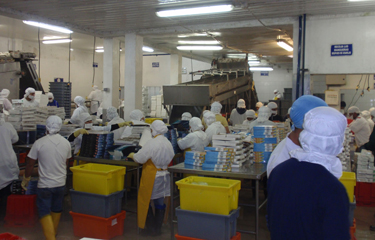Following diplomatic and technical negotiations, Ecuador has managed to reverse China's suspension of imports of shrimp from Industrial Pesquera Santa Priscila, according to an announcement from Ecuador’s Production, Foreign Trade, Investment, and Fisheries Ministry (Producción).
On 10 July, the General Directorate of Chinese Customs announced the suspension of three Ecuadorian shrimp companies – Industrial Pesquera Santa Priscila, Empacreci, and Empacadora Del Pacifico – from exporting to the country. According to reports from Chinese health authorities, samples taken from one of the internal walls of a container transporting Ecuadorian shrimp tested positive for COVID-19, as well as on the outer surface of five boxes from these companies.
“To achieve the lifting of the suspension, virtual reviews were made in the shrimp production and packing plants, and at pre- and post-shipment ports, showing that the product complies with the biosecurity protocols that the international market requires,” Producción Minister Iván Ontaneda posted on Twitter. “We are in the final stretch for the other two establishments to also overcome this impasse. The virtual inspections were carried out to satisfaction, with positive comments regarding the technological level of the plants and the protocols that are employed.”
The shrimp embargo sent Ecuadorian officials scrambling to defend the country’s second-largest after oil, and Producción credited the national government’s “timely deployment of diplomatic efforts in Beijing, as well as effective inter-institutional coordination and permanent public-private synergy” for the success.
China is the main destination for Ecuadorian shrimp, with the Asian country having purchased USD 510 million (EUR 447 million) in the first quarter of 2020 alone. Shipments to China by the three banned companies represent about 30 percent of all shrimp exports from Ecuador to China.
Producción reported Ecuador will sign a memorandum of understanding with China, with the purpose of formalizing the safety and biosafety protocols that are followed in the export of shrimp to China.
“The final version of the document was approved by both countries and will be made official in the coming days,” Producción reported.
However, sector observers have expressed doubt over a speedy recovery for Ecuadorian shrimp exports to China, noting that the episode has left the public distrustful and reluctant to purchase any imported seafood. For example, after health authorities found COVID-19 on fish-chopping boards in Beijing’s Xinfadi seafood market – the epicenter of a new cluster of infections – Chinese seafood shoppers were spooked by the supposed linkage between salmon and the coronavirus. Despite proof that there was no connection, sales of imported salmon plummeted.
Many of Ecuador’s shrimp producers have expressed concern that although the ban only targeted three companies, consumers could stop buying shrimp altogether.
Ecuador’s shrimp industry production has climbed steadily over the past decade, from 151,000 metric tons (MT) in 2010, representing USD 850 million (EUR 744 million) in exports, to 645,000 MT in 2019, representing USD 3.9 billion (EUR 3.4 billion).
Photo courtesy of Industrial Pesquera Santa Priscila







